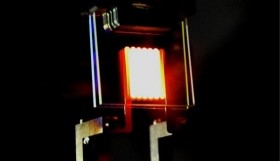We want our incandescent bulbs back
January 20, 2016
on
on

but not the ones with tungsten wires, these are now collector’s items and only available from under the counter. Using a technology called nanophotonics, researchers at MIT and Purdue University have built a more energy-efficient incandescent light bulb that combines, they say, "the warm look of traditional light bulbs with 21st-century energy efficiency."
While the focus of the research was on light bulb emission, it may also have applicability to other energy conversion technologies. The new structure is a conventional in-vacuum filament that has an outer coating or surround of a secondary structure that captures radiation outside the visible—- presumably, mostly in the infrared (IR) spectrum — and reflects it back to the filament to be re-absorbed and re-emitted as visible light.
These structures — a form of photonic crystal — are made of Earth-abundant elements and can be made using conventional material-deposition technology. They appear to be acting both as reflector at IR wavelengths and band-pass or high-pass spectral filter, in the visible. The (normally wasted) heat is returned to the filament and is additive with the resistive heating of the electric current in raising the filament temperature.
Theoretical efficiencies of as much as 40% have been quoted by MIT although the devices made so far have reached some 6.6% ... which is comparable with some compact fluorescent (CFL) and present-day LED lamps .. and three times better than the old incandescent.
The technology has potential for many other applications besides light bulbs, and could have dramatic implications for the performance of energy-conversion schemes such as thermo-photovoltaics where heat from an external source like chemical, solar, etc., makes a material glow, causing it to emit light that is converted into electricity by a photovoltaic absorber.
While the focus of the research was on light bulb emission, it may also have applicability to other energy conversion technologies. The new structure is a conventional in-vacuum filament that has an outer coating or surround of a secondary structure that captures radiation outside the visible—- presumably, mostly in the infrared (IR) spectrum — and reflects it back to the filament to be re-absorbed and re-emitted as visible light.
These structures — a form of photonic crystal — are made of Earth-abundant elements and can be made using conventional material-deposition technology. They appear to be acting both as reflector at IR wavelengths and band-pass or high-pass spectral filter, in the visible. The (normally wasted) heat is returned to the filament and is additive with the resistive heating of the electric current in raising the filament temperature.
Theoretical efficiencies of as much as 40% have been quoted by MIT although the devices made so far have reached some 6.6% ... which is comparable with some compact fluorescent (CFL) and present-day LED lamps .. and three times better than the old incandescent.
The technology has potential for many other applications besides light bulbs, and could have dramatic implications for the performance of energy-conversion schemes such as thermo-photovoltaics where heat from an external source like chemical, solar, etc., makes a material glow, causing it to emit light that is converted into electricity by a photovoltaic absorber.
Read full article
Hide full article


Discussion (0 comments)